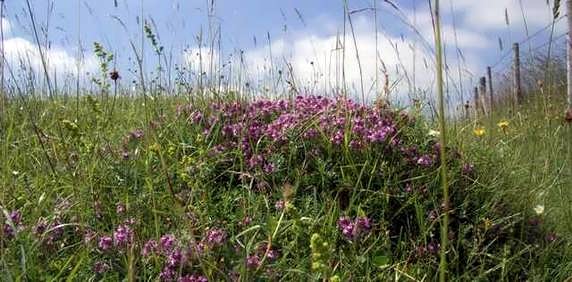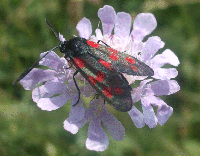Calcareous grasslands are fantastically and famously rich in plant and insect species, where traditionally managed. Often known as "downland" when on chalk, from its dun-brown colour in summer, botanists often boast of being able to find up to 40 different plant species in one square meter. In England a great chalk band runs from Dorset to the Wash. Limestone is characteristic of northern counties and dominates the Dales and the white Peak in Derbyshire and is just as varied, although some plants and insects don't make it to the cooler north.
 | wild thyme flowering on an anthill on chalk downland |
It is still possible to walk over downland in spring and find spectacular shows of common spotted, bee, fragrant, pyramidal and lesser butterfly orchids, and in summer smell the powerful scent of thyme underfoot with blue butterflies searching for nectar and places to lay their eggs between the anthills. The sward is thick with other small and beautiful flowers such as cowslips, salad burnet, early gentian, stemless thistle, rock rose, fairy flax to name but a few. Where the grassland is longer, black and greater knapweed and field scabious provide a breath taking show of purple flowers, often interspersed with yellow vetch. It is also a great hunting ground for plant and insect rarities. How can you not love it! This type of grassland is maintained through regular grazing by sheep and\or cattle, without which it quickly reverts to hawthorn scrub and then woodland. Much of the diversity of such rich grasslands has been destroyed in many areas by the use of artificial fertilisers introduced in the 1970s. Those which survived were generally too steep or uneconomic to "improve". Although some remained where farmers resisted the need for change. Traditionally sheep were grazed on downland during the day and then at night brought down to the arable fields where they were held in pens i.e. "folded". Their dung then become a fertiliser on the fields. In southern Wiltshire, for instance, many parishes are long a linear and were drawn up to follow this pattern of agriculture. They comprise of downland, arable fields, flood plain pasture and then they stop at the river in the valley bottom. The largest contiguous area of chalk grassland is on Salisbury Plain in Wiltshire. Here the landscape has escaped the changes of the last 60 years, seen on other agricultural land, due to its use as a military training area. On the "Plain" it is possible to see uninterrupted swaths of breath taking species rich grasslands in an ancient landscape, although you do need to watch out for obvious hazards such as tanks and unexploded shells! The soil that such grasslands can be found on is naturally low in nutrients and hence grass, especially if grazed, is not as dominant as it might otherwise be. This allows many flower species to establish. The grazing, however only allows grasses and flowers that grow low to the grow and can tolerate grazing and dry chalk soils. The level of grazing, and hence the length of the grass, greatly influences which flower and insect species can thrive. | 
